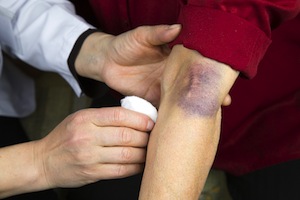 Closed wounds occur when the skin remains intact and the tissue that lies underneath is not exposed. They are usually caused by some sort of blunt trauma, such as when someone falls down. Car accidents commonly lead to this type of problem, which can damage bones, internal organs and muscles. Here is some information on they different varieties of closed wounds as well as how they are commonly treated.
Closed wounds occur when the skin remains intact and the tissue that lies underneath is not exposed. They are usually caused by some sort of blunt trauma, such as when someone falls down. Car accidents commonly lead to this type of problem, which can damage bones, internal organs and muscles. Here is some information on they different varieties of closed wounds as well as how they are commonly treated.
Types of Closed Wounds
Most people associate closed wounds with contusions, which typically appear as a bruise with bluish or reddish skin discoloration. However, there are several other types as well. For example, a hematoma is an injury that results in the pooling of blood, while a crush injury occurs when a part of the body is squeezed by a high-pressure external force.
Treatments for Closed Wounds
Closed wounds must be treated as soon as possible due to the potential complications that can arise. These include large bruises, severe bleeding, damage to internal organs and nerves, and bone fractures. But there is an even more serious complication known as compartment syndrome. This occurs when a limb is damaged and subjected to increased pressure and swelling. In extreme cases, the blood supply to a limb can be cut off completely, leading to long-term damage and potentially even amputation.
Common treatments include compression, ice, elevation and rest. However, if compartment syndrome is suspected, your doctor may need to make incisions into the affected area in order to reduce pressure. MRIs, CT scans and ultrasound may be used for other types of closed wounds in order to determine whether internal bleeding or organ damage has occurred.
Please get in touch with the experts at DFW Wound Care Center to learn how we treat closed wounds. Contact us online or give us a call at 972-665-6292 (Plano) or 972-318-2383 (Lewisville).
Contact us
Schedule an appointment
with our specialists by contacting us or calling our:
